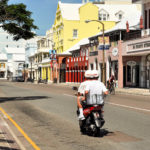(Updated February 2001)
Between heaven and earth there is a great watery salt plain where the heavens are mirrored in the horizon of the earth.  It is a remarkable illusion, with no distinction between clouds and terra firma. Blue layers of Altiplano sky on white layers of clouds spread out like a mother reflected in a child’s eye. The vision is a surreal scape of melded water, clouds and cerulean heaven with no distinctions.
It is a remarkable illusion, with no distinction between clouds and terra firma. Blue layers of Altiplano sky on white layers of clouds spread out like a mother reflected in a child’s eye. The vision is a surreal scape of melded water, clouds and cerulean heaven with no distinctions.
The Salar de Uyuni, Bolivia’s largest salt lake, was created forty thousand years ago as a flat bed into which the salty mineral residue drained from the mountains.
Today, the remnants of the ancient lake are two smaller lakes (or two enormous salt plains, depending on the season). The Salar de Uyuni, with over twelve thousand square kilometers, is one of the largest salt flats in the world; during the wet season it appears as a mirror lake that can be traversed not by boats but by four wheel vehicles– it is only six to twenty inches deep.
boats but by four wheel vehicles– it is only six to twenty inches deep.
Across the smooth-as-glass reflecting surface tourists and salt miners cut bizarre looking swaths of splash and they head out into the seemingly infinite emptiness of the sky-and-sea to one of the most unusual hotels in the world.
The hotel
Welcome to Hotel Playa Blanca located twenty miles out to sea in the middle of this giant sprawling reflecting pond. From a distance, the hotel floats like an austere mirage, still and silent on the polished horizon reflecting the ever-changing cloud sculptures. Closer up, the practical features are evident. The hotel sits on a built-up mound of packed salt three feet above the surface. The walls are built without wood, nails, mortar, adobe, bricks or plaster. Instead, the place is built entirely of salt blocks with a thatch roof.
 The blocks are twelve inches thick and ten inches high held together with little more than salt ‘mortar’ in the joints. Because the blocks are cut from layers of old deposits most of the blocks are stained and striated from minerals and dust that settled into the salt over the years, much like sedimentary glacier ice. The windows and doors have wood frames made locally.
The blocks are twelve inches thick and ten inches high held together with little more than salt ‘mortar’ in the joints. Because the blocks are cut from layers of old deposits most of the blocks are stained and striated from minerals and dust that settled into the salt over the years, much like sedimentary glacier ice. The windows and doors have wood frames made locally.
In each of the eight guestrooms native fabrics with traditional bright colors hang as curtains. The beds are comfortably covered in thick furs and two more salt blocks in the shape of a T serve as a bedside table.
There is no electricity and water is tanked in. This is one of those rare places where there is literally nowhere to go and nothing to do. Surprisingly, its austerity is actually quite tranquilizing.  For those who can stand the intense silence and get high on the awe of the night sky, this is a remarkable, if spartan, place to stay.
For those who can stand the intense silence and get high on the awe of the night sky, this is a remarkable, if spartan, place to stay.
In the communal dining hall the table and chairs are made of the same blocks covered with a table cloth and seat pads. The roof is a skeleton frame of loosely connected logs and timbers supporting not-so-thick brown thatch through which some light can be seen. It rains so rarely here that weatherproofing is hardly a concern.
During the wet season this may be the only hotel anywhere surrounded by water and accessed by four wheel vehicles. Despite the highly corrosive effects on the undercarriage of their (old) SUV Rovers and Toyotas, local tour guides transport visitors to the front steps of the hotel as well as various other sightseeing venues around the lake.
During the dry seasons (most of the year) the lake becomes a blinding white plain of geometric cracks and crystalline sculptures.
 Most of the overnight guests stay only one night because of the ascetic amenities. There is a kitchen but it is not exactly full service or equipped with refrigeration. Guest often bring their own food which the staff will prepare if asked. Because the hotel is located near the center of the lake, day-trippers are delivered here by the dozens in 4X4’s for lunch with food supplied by the guides.
Most of the overnight guests stay only one night because of the ascetic amenities. There is a kitchen but it is not exactly full service or equipped with refrigeration. Guest often bring their own food which the staff will prepare if asked. Because the hotel is located near the center of the lake, day-trippers are delivered here by the dozens in 4X4’s for lunch with food supplied by the guides.
During a typical lunch break there are people from Germany, Ukraine, France, Holland, USA or Australia eating in the dining room or outside sitting on salt-block benches arranged around salt-block tables. (One clever craftsman built a round table with small brown and white checkerboard inlaid on the top.) The surreal environment invites creative shutterbugs to take pictures of each other ‘standing’ on the water with infinity in the background.
For overnight guests the true delight that redeems these spartan quarters comes in the evening as the air cools and the sun begins its kaleidoscopic light show.  The unusual aspect of this spectacle is that the sunset is spread across the horizon virtually uninterrupted by any topography, in a full 180-degree arc. This great expanse is then doubled by its reflection in the glassy waters of the seemingly infinite lake. It is a prize of nature that far outweighs any modest inconveniences of the hotel– the visual equivalent of Dolby surround sound!
The unusual aspect of this spectacle is that the sunset is spread across the horizon virtually uninterrupted by any topography, in a full 180-degree arc. This great expanse is then doubled by its reflection in the glassy waters of the seemingly infinite lake. It is a prize of nature that far outweighs any modest inconveniences of the hotel– the visual equivalent of Dolby surround sound!
Looking out across the palette of this eerie and magnificent setting evokes a thought that this must be one of those places explorers imagine when they speak of going to the ‘ends of the earth’.
Mining the Salt
Away from the buzzing tourist traffic, on the shore of the lake is the village of Colchani sitting virtually alone atop billions of tons of easily accessible salt deposits.
 With the thickness of the salt layers up to six meters deep there is plenty of raw material for commercial purposes. This little settlement extracts and processes nearly 20,000 tons of salt each year, most of which is marketed for human consumption.
With the thickness of the salt layers up to six meters deep there is plenty of raw material for commercial purposes. This little settlement extracts and processes nearly 20,000 tons of salt each year, most of which is marketed for human consumption.
Despite the vast salt resources, the operations in Colchani are essentially primitive. Workers chop and shovel and the salt by hand from the flats onto lumbering old dumptrucks which haul it to the processing plants town.
The sifting, drying and bagging is done by the local village residents in a small three-room ‘factory’, working in small teams. Some of the women bring their children to play nearby or to help bag the salt. When the train pulls in headed north to La Paz or south to Argentina, local vendors sell small packages as souvenirs to tourists and as household salt to natives.
Larger block quantities are cut and processed at the Rosario Cooperative (known as the ‘Salt Blocks’) several miles away. Iodine is added according to WHO specifications and then shipped to refiners and sold abroad.
In the warmer seasons some of the locals trade their salt for wool and meat. In winter they load their lamas with salt cargo and trek it to Tarija, the provincial capital, and return with honey, maize, wood, coca leaves and other edibles that are scarce on the plain. One report claims this ‘Salt Trail’ has been active since the early 1600’s.
 In addition to table salt and building blocks, some of the salt pieces are carved into furniture, souvenirs and attractive art pieces such as birds in flight, llamas, pyramids or replicas of churches which are sold at various tourist venues in Uyuni, the nearest town. For those wanting to furnish their homes with larger items there are chairs, tables, benches and decorative blocks available.
In addition to table salt and building blocks, some of the salt pieces are carved into furniture, souvenirs and attractive art pieces such as birds in flight, llamas, pyramids or replicas of churches which are sold at various tourist venues in Uyuni, the nearest town. For those wanting to furnish their homes with larger items there are chairs, tables, benches and decorative blocks available.
Colchani is modest; the workers are peasants, possessions are few and opportunities and education limited. But within the frame of this humble lifestyle there is calmness induced by the expanse and tranquility of the great lake.
People here do not have to go ‘back to nature’. Their entire present is lived within the enormous dream-like splendor of the Salar de Uyuni which changes hue and mood in an endless migration of seasons. It is more than a place to visit; it’s a place to remember the soul of things.

Note: At the time of this story, a new hotel was under construction next to the older Hotel Playa Blanca. As of 2000 the new hotel is now in use. Called the Salt Palace (left), the place is more modern with better tourist amenities, but it ain’t the Ritz.
Also see:
Gay Bolivia News & Reports 2002 to present
Gay Bolivia Photo Gallery
















